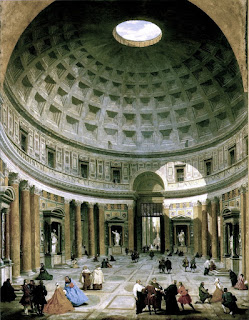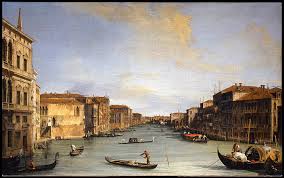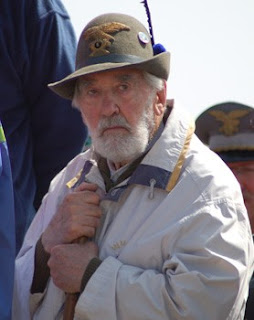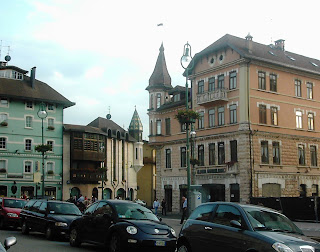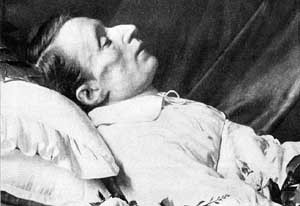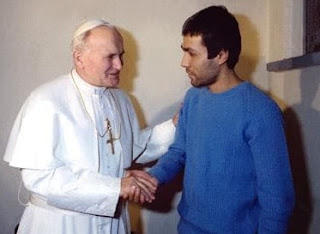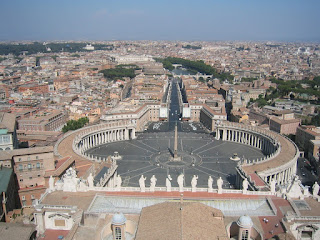Italy’s most successful First World War fighter pilot
 |
| Francesco Baracca alongside his Spad XIII with the family's prancing stallion logo displayed on the side |
Italy’s top fighter pilot of the First World War, Francesco
Baracca, died in action on this day in 1918.
He had been flying a strafing mission against
Austro-Hungarian ground troops in support of an Italian attack on the Montello
Hill, about 17km (11 miles) north of Treviso in the Veneto, on which he was
accompanied by a rookie pilot, Tenente Franco Osnago.
They split from one another after being hit by ground fire
but a few minutes later, Osnago saw a burning plane falling from the sky. Witnesses on the ground saw it too. Osnago
flew back to his base but Baracca never returned.
Only when the Austro-Hungarian troops were driven back was
the wreckage of Baracca’s Spad VII aircraft found in a valley. His body was discovered a few metres away.
A monument in his memory was later built on the site.
Osnago, fellow pilot Ferruccio Ranza and a journalist recovered his body.
It was taken back to his home town of Lugo in the province of Ravenna, where a
large funeral was held.
 |
| Francesco Baracca in his airman's uniform in 1916 |
It is thought that Barocca was seeking to provide Osnago
with cover from above as he swooped on enemy trenches when he was attacked by
an Austrian plane and downed. The
official version of events, written in the interests of propaganda, was that he
had been hit by groundfire but records later showed a kill claimed by the crew of an Austrian two-seater, who noted
the exact time and location of the engagement and took a photograph of the
shot-down aircraft.
Mystery surrounded the condition of Baracca’s body, which reportedly
bore the marks of a bullet to the head, while his pistol was out of its holster.
This led to speculation that he had taken his life as the plane fell, rather
than be killed in the crash or taken prisoner.
Baracca had claimed a total of 34 aerial victories, which
made him the most successful of all Italy’s First World War flying aces.
His first came in 1916, flying a French-built Nieuport II,
equipped with Lewis guns. His victim was
an Austrian Hansa-Brandenburg CI, which he hit in the fuel tank. It was also Italy's first aerial victory in
the war, brought about by what would become his favourite manoeuvre, which was
to zoom in unseen behind and below an enemy.
 |
| The monument to Baracca erected on the spot where his plane fell |
From the 1a Squadriglia Caccia, Baracca transferred to the
70a Squadriglia, where he was promoted to captain, before moving again, with
nine victories, to the newly formed 91st Squadriglia, known as the
"Squadron of the Aces", flying the Spad VII and Spad XIII planes.
Soon, his ever-increasing list of victories made him nationally famous.
He had entered the Military Academy of Modena in October 1907
and became a cavalryman with the prestigious Piemonte Reale Cavalleria Regiment
on his commissioning in 1910. He became interested in aviation and learned to fly at
Reims, France, receiving his pilot's licence in July 1912.
From a wealthy landowning background, Baracca had the title of Count. The family’s coat of arms bore the black prancing stallion symbol he attached to all his aircraft.
Baracca's mother is said to have presented the emblem, the Cavallino Rampante, to Enzo Ferrari, who
incorporated it as part of the badge displayed by cars belonging to his Scuderia
Ferrari racing team and in time all Ferrari automobiles.
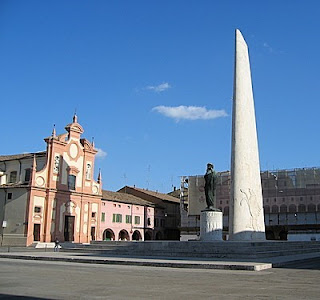 |
| Lugo's main square contains a huge memorial to Baracca |
Travel tip:
The town of Lugo, Baracca’s place of birth, is situated in
the Emilia-Romagna countryside between the cities of Bologna and Ravenna. From above, coincidentally, some say the shape
of the town resembles an aircraft. The town’s landmark is the Rocca Estense, an
Este-family fortress that now contains the town hall. Next to the fortress is a
monument to Baracca erected in 1936 and town also has a museum dedicated to
him, in his former house, which displays mementos, uniforms, medals from Baracca's life, as well as rudders and guns taken from shot-down aircraft.
 |
| Artillery shells stockpiled in Crocetta, which was on the front line in World War One |
Travel tip:
The village of Crocetta del Montello, once known as Crocetta
Trevigiana, the nearest community to where Baracca was shot down, suffered
badly because of the First World War. It had become prosperous after the construction,
in 1882, of a vast hemp rope mill, providing employment and helping the area
acquire resources including electricity, thanks to water-driven generators set
up on the Brentella river. But the mill was destroyed during the 1918 battle
that Baracca was supporting – the Battle of the Solstice. It was rebuilt only to be hit by global financial crises,
forcing it to close in 1938, leaving an unemployment problem and triggering the
bankruptcy of many local businesses that depended on it





